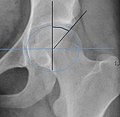X-ray of hip dysplasia

Hip dysplasia is a condition where the hip joint does not properly form in infants and young children. It is a developmental disorder that can lead to problems with mobility and pain in the hip as the child grows. The condition can be unilateral (affecting one hip) or bilateral (affecting both hips). Early detection and treatment are crucial in managing hip dysplasia effectively.
Causes and Risk Factors[edit]
The exact cause of hip dysplasia is not fully understood, but it is believed to be influenced by genetic and environmental factors. Risk factors include a family history of the condition, female sex, firstborn status, and conditions in utero that restrict fetal movement, such as oligohydramnios.
Diagnosis[edit]
Diagnosis of hip dysplasia is often made through a combination of physical examinations and imaging techniques. In newborns, the Ortolani and Barlow maneuvers are commonly used to detect hip instability. Ultrasound is used for infants less than six months old, as their cartilaginous structures are not yet visible on an X-ray. For older infants and children, an X-ray of the hip is the standard imaging technique to assess the alignment of the hip joints and the development of the acetabulum.
Treatment[edit]
Treatment for hip dysplasia depends on the age of the child and the severity of the condition. In infants, treatment often involves the use of a Pavlik harness, which holds the baby's hips in a position that encourages proper development of the joint. Older children may require more invasive treatments, such as bracing, casting, or surgery to correct the alignment of the hip joint and ensure proper development.
Prognosis[edit]
With early detection and appropriate treatment, most children with hip dysplasia can lead normal, active lives without significant limitations. However, untreated hip dysplasia can lead to complications such as osteoarthritis and chronic pain in later life.
Prevention[edit]
There is no known way to prevent hip dysplasia, but early detection and treatment can prevent the progression of the condition and minimize the risk of complications. Regular check-ups during infancy and early childhood are essential for early diagnosis and management of hip dysplasia.
-
X-ray of hip dysplasia
-
X-ray of hip dysplasia
-
X-ray of hip dysplasia
-
X-ray of hip dysplasia
-
X-ray of hip dysplasia
-
X-ray of hip dysplasia
-
X-ray of hip dysplasia
-
X-ray of hip dysplasia
-
X-ray of hip dysplasia
-
X-ray of hip dysplasia
-
X-ray of hip dysplasia
-
X-ray of hip dysplasia
Ad. Transform your life with W8MD's Budget GLP-1 injections from $75


W8MD offers a medical weight loss program to lose weight in Philadelphia. Our physician-supervised medical weight loss provides:
- Weight loss injections in NYC (generic and brand names):
- Zepbound / Mounjaro, Wegovy / Ozempic, Saxenda
- Most insurances accepted or discounted self-pay rates. We will obtain insurance prior authorizations if needed.
- Generic GLP1 weight loss injections from $75 for the starting dose.
- Also offer prescription weight loss medications including Phentermine, Qsymia, Diethylpropion, Contrave etc.
NYC weight loss doctor appointmentsNYC weight loss doctor appointments
Start your NYC weight loss journey today at our NYC medical weight loss and Philadelphia medical weight loss clinics.
- Call 718-946-5500 to lose weight in NYC or for medical weight loss in Philadelphia 215-676-2334.
- Tags:NYC medical weight loss, Philadelphia lose weight Zepbound NYC, Budget GLP1 weight loss injections, Wegovy Philadelphia, Wegovy NYC, Philadelphia medical weight loss, Brookly weight loss and Wegovy NYC
|
WikiMD's Wellness Encyclopedia |
| Let Food Be Thy Medicine Medicine Thy Food - Hippocrates |
Medical Disclaimer: WikiMD is not a substitute for professional medical advice. The information on WikiMD is provided as an information resource only, may be incorrect, outdated or misleading, and is not to be used or relied on for any diagnostic or treatment purposes. Please consult your health care provider before making any healthcare decisions or for guidance about a specific medical condition. WikiMD expressly disclaims responsibility, and shall have no liability, for any damages, loss, injury, or liability whatsoever suffered as a result of your reliance on the information contained in this site. By visiting this site you agree to the foregoing terms and conditions, which may from time to time be changed or supplemented by WikiMD. If you do not agree to the foregoing terms and conditions, you should not enter or use this site. See full disclaimer.
Credits:Most images are courtesy of Wikimedia commons, and templates, categories Wikipedia, licensed under CC BY SA or similar.
Translate this page: - East Asian
中文,
日本,
한국어,
South Asian
हिन्दी,
தமிழ்,
తెలుగు,
Urdu,
ಕನ್ನಡ,
Southeast Asian
Indonesian,
Vietnamese,
Thai,
မြန်မာဘာသာ,
বাংলা
European
español,
Deutsch,
français,
Greek,
português do Brasil,
polski,
română,
русский,
Nederlands,
norsk,
svenska,
suomi,
Italian
Middle Eastern & African
عربى,
Turkish,
Persian,
Hebrew,
Afrikaans,
isiZulu,
Kiswahili,
Other
Bulgarian,
Hungarian,
Czech,
Swedish,
മലയാളം,
मराठी,
ਪੰਜਾਬੀ,
ગુજરાતી,
Portuguese,
Ukrainian












